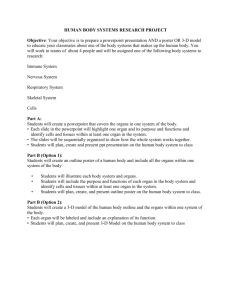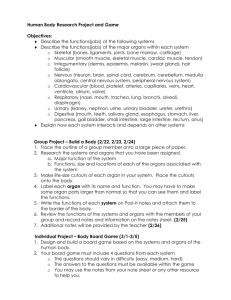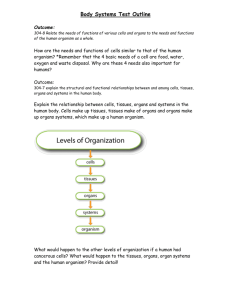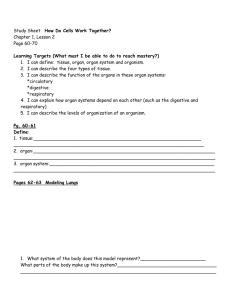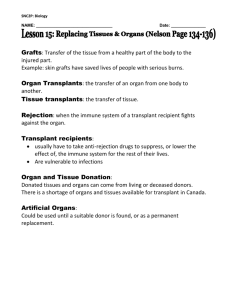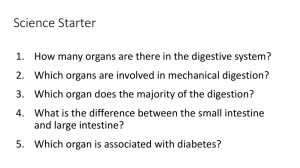HUMAN BODY SYSTEMS FINAL PROJECT
advertisement
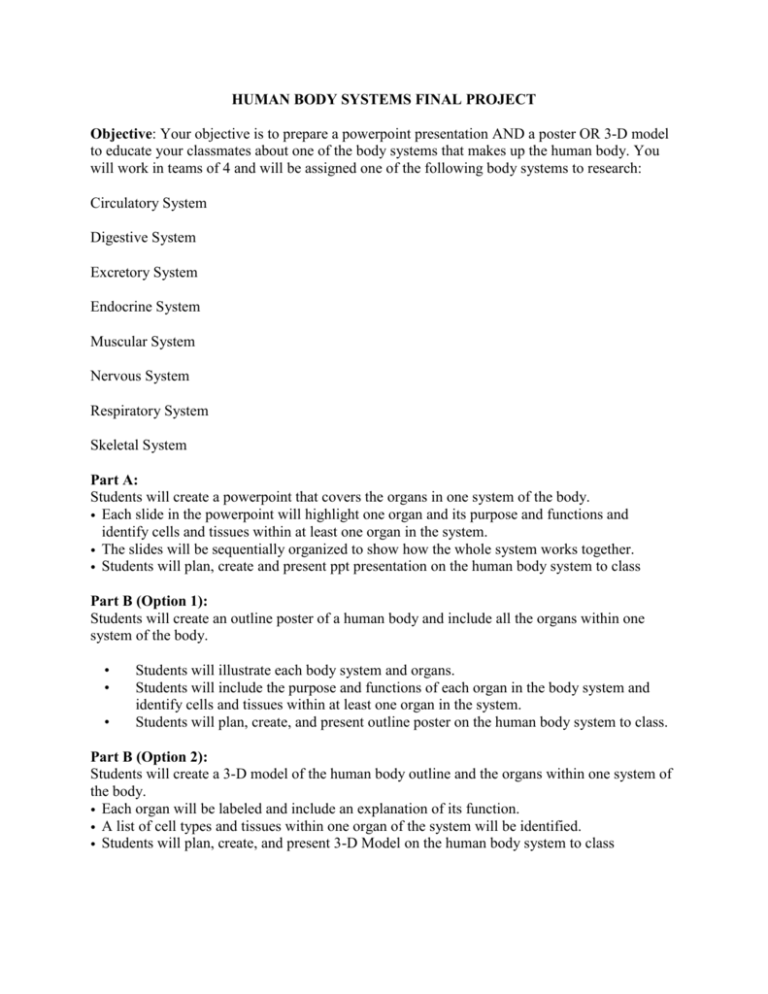
HUMAN BODY SYSTEMS FINAL PROJECT Objective: Your objective is to prepare a powerpoint presentation AND a poster OR 3-D model to educate your classmates about one of the body systems that makes up the human body. You will work in teams of 4 and will be assigned one of the following body systems to research: Circulatory System Digestive System Excretory System Endocrine System Muscular System Nervous System Respiratory System Skeletal System Part A: Students will create a powerpoint that covers the organs in one system of the body. • Each slide in the powerpoint will highlight one organ and its purpose and functions and identify cells and tissues within at least one organ in the system. • The slides will be sequentially organized to show how the whole system works together. • Students will plan, create and present ppt presentation on the human body system to class Part B (Option 1): Students will create an outline poster of a human body and include all the organs within one system of the body. • • • Students will illustrate each body system and organs. Students will include the purpose and functions of each organ in the body system and identify cells and tissues within at least one organ in the system. Students will plan, create, and present outline poster on the human body system to class. Part B (Option 2): Students will create a 3-D model of the human body outline and the organs within one system of the body. • Each organ will be labeled and include an explanation of its function. • A list of cell types and tissues within one organ of the system will be identified. • Students will plan, create, and present 3-D Model on the human body system to class Research Your textbook and the following websites will be a good start to your research: http://www.stcms.si.edu/hbs/hbs_student.htm http://kidshealth.org/kid/htbw/htbw_main_page.html http://www.imcpl.org/kids/guides/health/index.html http://www.fi.edu/learn/heart/systems/systems.html http://www.sciencenetlinks.com/interactives/systems.html (Fun interactive game) Project Rubric Use this rubric as a checklist to help you earn an A+ on your project! Part A: PowerPoint Presentation : 50 points Title slide and title 8 slides or brochure sections contain the following information at least 8 graphics Lists and explain the functions of the organ system 10 Identifies the major organs and their functions Describes the basic structure of at least one major organ in the body system Describes a disease associated with their body system 5 fun facts about your system 5 2 3 5 10 5 Part B: Poster or Model: 50 points Title and Name 2.5 Outline of body 2.5 Diagram of major organs in anatomically correct locations 20 Lables of major organs Neat, easy to understand colorful and creative 10 15 10 Body System Checklist Circulatory System Major functions of circulatory system • Diagram that includes the major parts - heart, artery, vein, capillary - and list the • function(s) of each. Describe each of the components of blood- red blood cells, white blood cells, platelets, & • plasma Describe the path blood travels through your body • Explain how your body system works with other systems in the body. Use 2 examples. • Find 5 fun facts about your body system. • Describe two diseases associated with your body system • Digestive System Major functions of digestive system • Diagram that includes the major parts - mouth, esophagus, stomach, small intestine, liver, • pancreas, and large intestine - and list the function(s) of each. Describe the path food travels throughout the digestive system. • Explain how your body system works with other systems in the body. Use 2 examples. • Find 5 fun facts about your body system. • Describe 2 diseases associate with your body system. • Endocrine System Major functions of endocrine system • Describe what hormones are and what they do • Diagram that includes the major parts - hypothalamus, pituitary, thymus, thyroid, • parathyroid, adrenals, pancreas, ovaries, and testes - and list the function(s) of each. Explain how your body system works with other systems in the body. Use at least 2 • examples. Find 5 fun facts about your body system. • Describe 2 diseases associated with your body system. • Excretory System Major functions of excretory system • Diagram that includes the major parts - lungs, kidneys, urinary bladder, ureter, urethra, • liver, and skin - and list the function(s) of each. Explain how your body system works with other systems in the body. You will need at • least 2 examples. Find 5 fun facts about your body system. • Describe 2 diseases associated with your body system. • Muscular System Major functions of muscular system • Describe the function and locations of each type of muscle – skeletal muscle, smooth • muscle, and cardiac muscle • • • • • Diagram that includes the major muscles in the body - biceps, oblique abdominis, sartorius, deltoid, orbicularis oculi, sternomastoid, gastrocnemius, pectoral, temporalis, gluteus maximus, quadriceps, tibialis, masseter, rectus abdominis, and triceps Describe how muscles work in pairs to make parts of the body move using the biceps and triceps as an example. Explain how your body system works with other systems in the body. You will need at least 2 examples. Find 5 fun facts about your body system. Describe 2 diseases associated with your body system. Nervous System Description and major functions of the central nervous system and peripheral nervous • system. Diagram that includes the major parts - brain, spinal cord, nerves, and neurons - and list • the function(s) of each. Describe the path a nerve impulse travels throughout your body from stimulus to • response. Explain how your body system works with other systems in the body. You will need at • least 2 examples. Find 5 fun facts about your body system. • Describe 2 diseases associated with your body system. • Respiratory System Major functions of respiratory system • Diagram that includes the major parts - trachea, lungs, diaphragm, epiglottis, larynx, • vocal cords - and list the function(s) of each. Describe the “breathing” process. • Explain how your body system works with other systems in the body. You will need at • least 2 examples. Find 5 fun facts about your body system. • Describe 2 diseases associated with your body system. • Skeletal System Major functions of skeletal system • Diagram that includes the major parts -bones, ligaments, and tendon - and list the • function(s) of each. NOTE: Your diagram should also include the following bones in the body: cranium, clavicle, humerus, scapula, sternum, rib, vertebra, ulna, radius, carpals, metacarpals, phalanges, pelvis (may list parts), femur, patella, tibia, fibula, tarsals, and metatarsals. Describe each of the following joints and where they are located: hinge, pivot, and ball• and-socket. You may include other joints as well. Explain how your body system works with other systems in the body. You will need at • least 2 examples. Find 5 fun facts about your body system. • Describe 2 diseases associated with your body system. •


